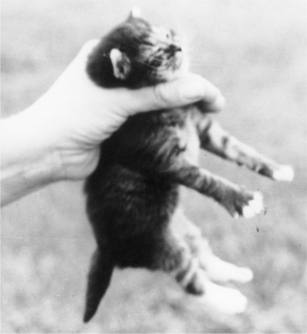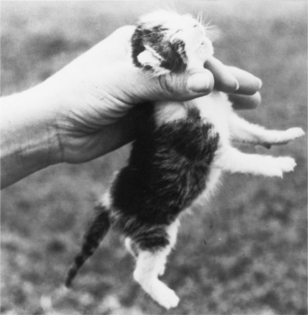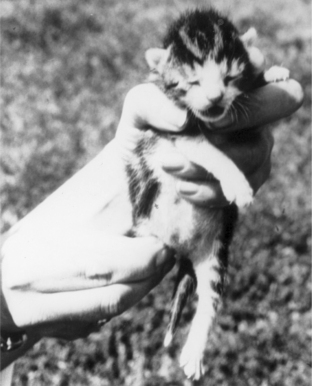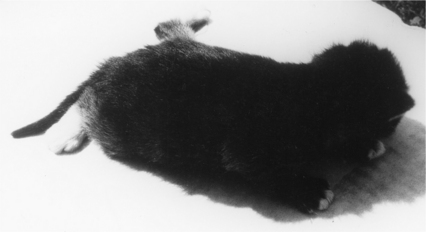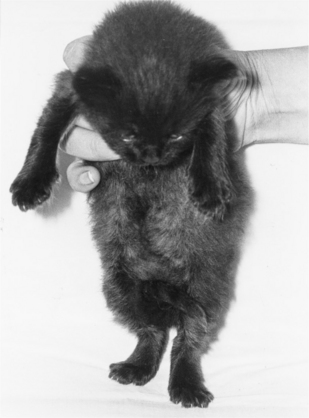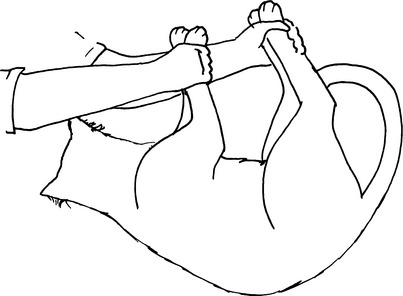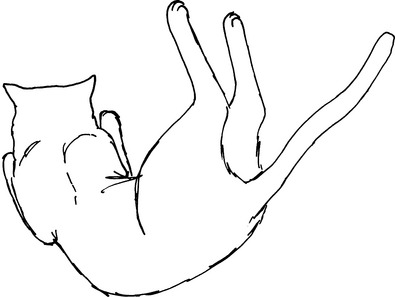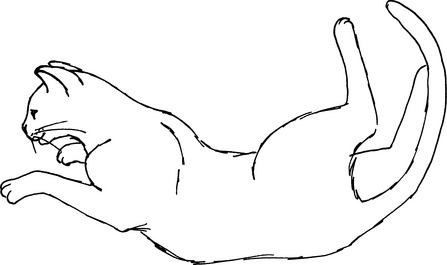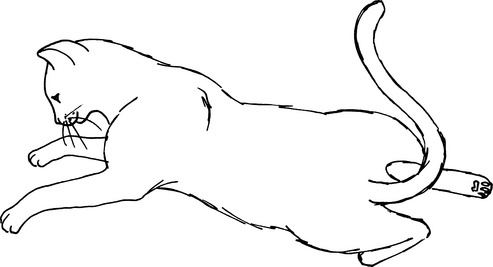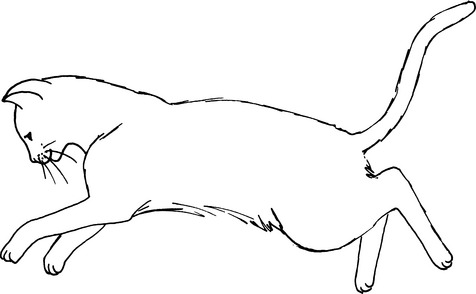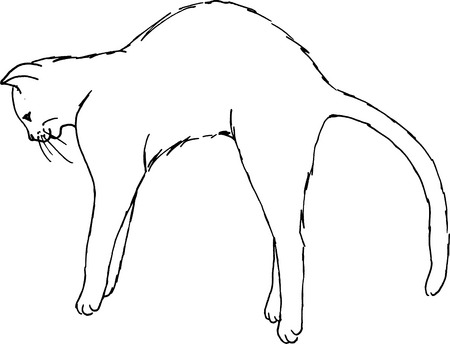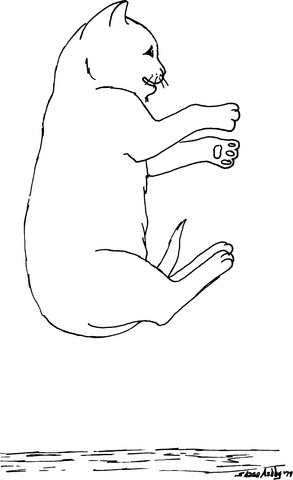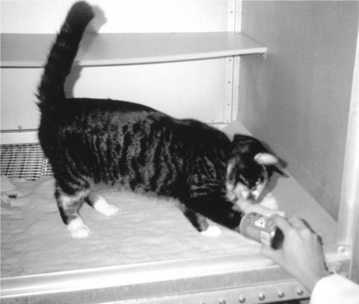Chapter 9 Feline Locomotive Behavior
The life of a cat is basically one revolving around eating, sleeping, and reproducing. Because of this, the ability to ambulate at various speeds is an absolute necessity. In this regard, the locomotor patterns and their reciprocal sleep patterns have been specialized to allow successful hunting and survival, as well as adequate rest. The comparative development of these patterns is shown in Appendix C.
Fetal Growth and Movements
The kitten begins in utero the development of movement patterns that will be necessary in the adult, and these patterns, as with sensory systems, parallel the development of the nervous system.77 Neuronal pathways become myelinated in their phylogenetic order of development.78
Approximately 25 days after conception, the 15- to 16-mm fetal kitten shows its first spontaneous movement as a unilateral flexion of its head and passive flexion of its shoulder. After growth of a few more millimeters, spontaneous neck mobility increases and local response to touch develops, along with ventral neck flexion, bilateral flexion of the head and upper neck, and rotation of the head. By 20-mm crown to rump length, the embryo will begin to show flexion of the lumbar and sacral vertebral column and active flexion of the shoulder joint.150,151
During the twenty-sixth day after conception (21 to 22 mm), rotation of the trunk first occurs, as does flexion of the elbow. In another 2 days flexion of the hips is seen, probably in passive response to the waves of muscular movements along the body. Motor responses continue to develop, so by day 30 (27 to 30 mm), flexion of the carpus and slight activation of the masticatory muscles occur. Flexion of the tail can be observed at 33 days (38 mm), as can adduction of the forelimb. During this time of completion of facial and forelimb muscular development, there is also flexion of the stifle, extension of the vertebral column and manus, and withdrawal by flexion from a touch sensation. By 36 days (50 mm), the abdominal and intercostal muscles begin to function.150,151
Sometime between 38 and 40 days after conception (60 mm), flexion of the tarsus begins and tongue muscles begin to function. By 42 days (75 to 80 mm) the pes flexes and the diaphragm starts functioning; however, breathing movements are not regular for another 7 days. After an additional 8 days of growth (100 mm), most motor responses have been shown. The pelvic limb is capable of adduction and digital flexion, and the muscles of facial expression and those of the larynx associated with phonation become active.150
Spontaneous body-righting capabilities are initially present at about 50 days (100 mm), although they are by no means adultlike and are probably not vestibular in origin.41,149,150 Vestibular righting does not appear until approximately 4 days (15 mm) later.149 Several sensory reflexes develop about the same time as the spontaneous body righting, including the scratch, sucking, light blink, and forelimb crossed-extensor reflexes. The ear-scratch reflex develops at this time also, as does ipsilateral flexion and contralateral extension of the forelimb.38,150 The coordinated action of the limbs necessary for progressive forward movement occurs near term, indicating that the coordination involved in walking is innate, not learned.41
Infant Growth and Movements
Prewalking Movements
At birth the motor skills continue to mature in conjunction with the central nervous system, but additional motor behaviors can be learned. Movements initially involve the whole limb, but with time and maturation, discrete segmental movements are employed.22 Neonatal movements toward the queen are the stiff paddling-like motion of the forelimbs that matured shortly before birth, and these movements are sufficiently coordinated within 8 minutes of birth to pull the suckling for the short distances it must travel. The limbs still lack a great deal of motor coordination and strength because they are unable to bear weight and the claws are not retractable. The poorly developed motor coordination at this stage functions to prevent the young from wandering. Thermoregulation is also poorly developed until approximately 2 weeks of age and further serves to keep the kittens close to one another and to the queen. A strong rooting response, the burrowing into warm objects, is present for up to 16 days, giving an indication about the progression of homeostatic mechanisms (see Figure 2-9).
The body-righting response that occurs when kittens are accidentally pushed over by the queen is also continued from the prenatal behaviors and is fully mature by 1 month.89 The righting response of cats dropped from a height does not appear until 35 days.134 Vestibular function develops slowly during the first few days of life. Nystagmus associated with rotatory stimulation appears experimentally at the end of the first week, although it has been associated with deviation of the eyes and oscillating eye movements during this early appearance. Vestibular nystagmus becomes adultlike by the end of the third week.34
Flexor and extensor dominance of the vertebral musculature, caused by an imbalance of the nervous innervation to them, is not highly consistent among kittens. Flexor dominance is present in most kittens from birth into adolescence (Figure 9-1). After approximately the first month, the curled-up posture may modify so that the neck is extended, but the rest of the body position is similar to what it had been. Extensor dominance is much more variable. Starting as early as day 1, this activated vertebral extensor stage can also last into adolescence (Figure 9-2). Kittens may initially exhibit extensor dominance and then within a few seconds progress into a more prolonged flexor dominant stage. This dual sequence is especially noticeable between days 15 and 40. Other kittens show neither dominance at birth, and others exhibit a great deal of squirming when suspended from the neck.
Nonvisual placing of a limb onto a surface in response to its touching the edge of the surface occurs consistently for the thoracic limbs first, sometime during the first 5 days of life (mean 2.3 days; see Figure 2-12). Development of nonvisual placing of the pelvic limbs is much less uniform and may initially appear during the first 12 days (mean 3.6 days), although not consistently until sometime during the first 19 days (mean 11.3 days).
The forelimb crossed-extensor reflex is acquired by some individuals before birth. For others, this reflex and the hindlimb crossed-extensor reflex may appear up to the third day of life (mean 1.4 days), although either or both may never develop (Figure 9-3). The crossed-extensor reflex will end between days 2 and 17 (mean 8.1 days).
Body support by the limbs develops in four stages shortly after birth. In the first stage, when the kitten is held by the lumbar and pelvic areas and lowered to a table, its forelimbs will start to support weight between 1 and 10 days of age (mean 3.5 days). Direct forelimb support of the body weight, the second stage, also appears during the first 10 days, but the mean is 5.7 days (Figure 9-4). Pelvic limb support, the third stage, begins to be demonstrated during the first 16 days (mean 14.3 days) when the kitten is suspended by the thorax and the pelvic limbs are allowed to touch the table (Figure 9-5). Finally, the ability to completely elevate the body off the ground by the additional strength in the rear limbs begins between days 5 and 25 (mean 10 days).
Walking and Other Later Movements
Once walking has begun, several behaviors change. The avoidance reaction progresses from a primitive stage, in which the kitten vocalizes and squirms, to one more typical of an adult, in which it backs away from the stimulus. This latter type of avoidance appears about the twenty-fifth day.130 Kittens actively approach specific people and littermates as early as 18 days of age, especially if the earlier experience has been enriched by handling, and they become good followers, a necessity so that they can undergo visual learning from the queen’s examples.37,116 Running first appears toward the end of the third or fourth week, and it is accompanied by the onset of active social play. Shortly thereafter the kitten has matured enough for the air-righting reflex to have developed, and all gaits in adult locomotion are in use by 7 weeks.22,89
Within a few days of walking, generally between 23 and 40 days of age (mean 31 days), the kitten will start climbing, usually in an attempt to escape from the nesting box. At first these escapes are brief, but within 5 days, 68% of the young one’s time is spent out of the box.107 By 8 weeks of age, 82% of the time is spent out, an increase that coincides with the time the kitten changes its orientation from the home area to the queen.107,110,111 Once out of the box, the kitten’s climbing attempts will then be made on other environmental obstacles. Success in climbing is related to another factor: control of the claws. During the first 2 weeks of life, the young cat does not have the ability to retract its claws. Through a gradual process, control is gained over the retractability, and by 3 weeks the kitten has reasonable control over its distal phalanges.
Sensorimotor Coordination
The sense of vision plays a significant role in the development of certain aspects of locomotion. Kittens raised experimentally without being able to see their forelimbs are not able to place their feet accurately at a later age. In addition, batting at dangling objects, reaching for objects, or avoidance stepping is not very successful for these individuals, because the controlled placing response requires a certain amount of integration of the visual and motor systems.50,52 Kittens allowed to watch one paw but not the other will permanently be unable to guide the unseen paw.50,51 Similar studies have been conducted under conditions of light deprivation. After a minimum of 4 weeks of darkness, visual depth discrimination is affected. However, minimal stimulation, such as 1 hr/day of exercise on a patterned surface, with exercise being the key factor, results in normal movement discrimination.108,137 Time to develop this ability in older kittens who have been deprived is somewhat similar to that required for visually normal neonates to acquire it after birth.133 For the kitten that has visual stimulation but is experimentally never allowed to propel itself, with locomotion supplied by others, visually guided behavior is severely affected.53 Therefore both factors are necessary for sensorimotor coordination.
Eye-paw coordination is necessary for locomotor play with inanimate objects. This type of play increases sharply around 7 to 8 weeks with the maturation of both sensory and motor systems.89 More complex tasks such as walking and turning on a narrow plank are not seen until 10 or 11 weeks of age.89
Adult Movements
Adult cats are active throughout a 24-hour period, with two peak activities that are apparently influenced by environmental factors.101 In farm cats, 62.6% of the active behavior occurs during daylight hours.101 In suburban cats, most occurred between 6 pm and 4 am.8 This type of activity pattern is also reflected on the circadian pattern of cortisol production, with the highest endogenous production in the evening and the lowest in the morning.103 Free-roaming farm cats will travel between 24.5 and 53.3 minutes in this time, not counting the additional 3.6 hours they spend hunting.101 While roaming the cat will cover 176±765 m, and not counting meandering, the distance covered in any 1 hour does not exceed 750 m.101 House cats will normally spend 3% of their time standing, 3% walking, and 0.2% highly active.4 Most of the time they are on the ground, but 20% of time will be spent at a height up to 1 m, and 4% of time will be spent at a location higher than 1 m.4
Active movement for adult cats involves several gaits, and these patterns of movement can be described as alternative or in-phase locomotion.92 A gait has been described as an accustomed, cyclic manner of moving in terrestrial locomotion.59 In animals, there are at least 13 named gait sequences, many of which are used by cats. In alternative gaits (walk, amble, trot), the ipsilateral limbs strike at alternate halves of stride. In-phase gaits (pace, gallop) are characterized by limbs on the same side of the body moving forward during the same part of the stride. Because gaits differ between ground and treadmills,9 natural movement should be used to describe cat locomotion.
Walking
The walk is a four-beat gait, meaning that each of the cat’s paws contacts the ground at a separate time during the stride. During any one phase of this gait, there are at least two feet having ground contact. In a slow walk, such as the stalking walk, there are usually three and occasionally four contacting feet (Figure 9-6). The rapid walk has two or three feet on the ground at a time (Figure 9-7). The walk has also been described as symmetric, because the left limbs repeat the position of the right, one half stride later. The forward speed is approximately 0.9 m/sec; however, a rapid walk will almost double the rate.39,42
About 60% of the body weight load is carried by the thoracic limbs, primarily because the center of gravity is closer to them. As the cat moves from four legs on the ground to three, the majority of weight will be supported by the diagonally opposing limb pair. The center of gravity also shifts toward those limbs, ending up within a triangular area determined by the three supporting limbs.21
Vertical and horizontal forces are associated with walking, with the vertical thrust fluctuating between a high of approximately 4000 g to a low of approximately 2600 g twice during each complete cycle. At normal speed, the maximal vertical thrust is realized during the three-foot support phase, and minimal thrust occurs when only two paws are on the ground. Individual horizontal forces are greater for the thoracic limbs than for the pelvic limb counterparts. Both the period of forward propulsion and that of negative, retarding propulsion, when the forelimb is being returned to a cranial position, provide greater calculated values than corresponding values for the pelvic limbs. Because of the vertical thrust of the forelimbs, however, the net longitudinal force is a small forward impulse, much less than for the hindlimbs.42,88 In forward movement, the primary function of the thoracic limbs is to produce the upward acceleration of the body, and that of the pelvic limbs is for forward progress. Force changes associated with each limb are consistent for that animal but will differ between individuals.21 If an obstacle hinders the forward swing of a foot, the cat will quickly respond by lifting the foot over the obstacle, possibly indicating spinal rather than cortical control.139 Neural and electromyographic aspects of locomotion have also been studied.30,145,146
Ambling
Another four-beat gait used by the cat has been referred to by a number of terms, including the amble, slow pace, running walk, and walk. The footfall pattern is the same as for the walk, but the timing of the placement of the limbs differs (Figures 9-8 and 9-9). At this gait, the cat has the appearance of moving the limbs on one side of the body forward at almost the same time. Whether the cat uses the walk, amble, or a sequence somewhat in between is an individual factor.
Trotting
For traveling long distances at fair speed, the trot is most often used. This two-beat gait is less tiring than other gaits because there is less body movement over the center of gravity. An added feature, as a result of steadying the shift of gravity, is that the gait then provides more stability of footing. To achieve this symmetric gait, the contralateral forefeet and hindfeet are on the ground simultaneously. At normal or fast speeds, one pair of contralateral paws propels the body forward, leaving a brief suspended interval when no limbs are supporting the body (Figure 9-10). The alternate pair of limbs then lands and pushes off to complete the cycle. At a slow rate of speed, the suspension stage does not occur, because the third and fourth paws contact the ground before the first and second leave it (Figure 9-11).
Pacing
Another two-beat gait of fair speed, the pace, is not commonly used by cats. Except that ipsilateral limbs move forward and back as a unit, the ground contact and suspension phases are the same as those described for the trot (Figures 9-12 and 9-13).
Galloping
When speed is needed to chase prey or escape enemies, the gallop is used. This four-beat, asymmetric gait has several variations, depending on the speed needed and the individual performing it. At a slow rate (a gait that is also called a canter), there is at least one paw on the ground at all times or as many as three during certain phases (Figure 9-14). As the caudal paws touch the ground, the foot contacting the ground last is positioned in advance of the other. The same positioning occurs when the cranial paws land. The foot that lands last and ahead of its counterpart may be termed the lead foot, and if these were the right forelimb and the right hindlimb, the cat could be said to have the right lead in front and the right lead behind.
When its speed increases, the cat has a suspension phase after the push with the pelvic limbs (Figure 9-15). At great speed, a second suspension phase occurs after the push by the thoracic limbs (Figure 9-16). About 80% of a stride is spent in extended flight, almost 20% in forelimb ground contact, and a very minimal amount in ground time for the pelvic limbs.39 Generally, at faster speeds, the cat will lead with opposite feet, fore and rear, to allow for overreaching as a result of the great amount of flexion in its back. The supple spine can increase the speed and length of each stride by several inches. If the vertebral column extends just before the last limb leaves the ground, before the suspended phase, and does not flex until the next limb touches the ground, the effect is that of adding several inches to the length of the animal and thus of adding length to its stride. If the extension occurs after the cat is airborne, the effect on the stride and speed is nullified.58 Faster speeds require more energy to obtain the suspension phase and therefore are seldom maintained for prolonged distances.
A very short, fast chase has also been termed dashing and is generally thought to use the half-bound variation of the gallop23,39 (Figure 9-17). At this gait, the cat pushes off with both hindfeet at the same time, although they are usually not positioned adjacent to each other. When landing on the forepaws, the cat has a timing sequence that is the same for the gallop: One limb lands first and will be caudal to the second.
Climbing
A general concept associated with cats is that they climb trees. Some individual cats, notably Siamese, will spend a considerable amount of time on tall objects, including ceiling beams, roofs, and people, as well as trees, but prefer to find these new or odd places themselves. Thus climbing is an important part of the cat’s locomotor behavior. Cats that like to climb people often learn this behavior as a kitten from owners who do not discourage it or, in some cases, actually encourage this “cute” kitten behavior. For the adult animal, climbing may represent an attempt to get close to the person’s face, as in the facial approach of social greeting, or it may be an attempt to get to a higher location, especially if the shoulder or head is the final destination. The movement of limbs in climbing follows the same sequence as that used for walking: It is a four-beat rhythm. If the cat is in a hurry, however, a form of gallop pattern is used. The presence of claws is not required for climbing all objects, although claws are used if they are present. The removal of these ungual processes may necessitate a feline relearning experience.
Air Righting
Cats have the ability to alter their position in midair so that they can land feet first after a fall. Air righting develops over time and will be seen first as a head rotation, which is shortly followed by the beginning of a rotation of the trunk. The reflex appears between 21 and 30 days of age (mean 23.5 days), with complete righting abilities being perfected between 33 and 48 days (mean 40 days).16,22,140 Deaf cats will develop this reflex because their vestibular apparatus is seldom defective. Sight is required to perfect the righting reflex, the development of which correlates with that of visual acuity; however, once righting abilities are perfected, blindfolding the cat does not greatly hinder the process.
A cat that is dropped with its feet generally higher than its body responds by turning so that it will land on its feet. The basic occurrences that result in this air righting begin when the vertebral column flexes so that the cranial half of the body is at an approximate right angle from the initial starting position (Figure 9-18). The thoracic limbs are held close to the body while the pelvic limbs and tail are held away from the trunk (Figure 9-19). The cranial half is then rotated 180 degrees about its axis while this motion is offset by a 5-degree counterrotation of the caudal body (Figure 9-20). The thoracic limbs now are extended and vertical, and the pelvic limbs retain their relationship with the caudal part of the body, although they are flexed slightly (Figure 9-21). Then the caudal body rotates to line up with the front of the body (Figure 9-22). Occasionally cats may overrotate the caudal body by as much as 30 degrees, but a counterrotation by the tail and other body muscles usually corrects this problem rapidly. The original flexion of the vertebral column is maintained during the turn so that when the cat lands the back is arched with the four limbs extended65,90 (Figure 9-23).
When falling, a cat can turn in a distance equal to that of its standing height and in a time span between 0.125 and 0.5 second.65,90 Because it takes 0.4 second to fall 5 feet, most cats are capable of making the turn.65,120
Many remarkable falls have been survived by cats, some even without physical damage. The free-fall record was 129 feet, or 11 stories, by a London cat in 1965.152 Later reports have taken into account the surface landed on, and survival records for those have been established. When the landing is a hard surface, 18 stories have been the maximal distance survived; 20 stories are the maximal for shrubbery; and 28 stories is the maximal for a canopy or awning.109 When falling, a cat reaches a terminal velocity approaching 40 mph in 60 feet.90 Theoretically then, if a cat can survive a fall of 60 feet, it should be able to withstand a fall from any height.
Most cats have an excellent sense of balance, but when they do slip from a precarious perch or fall out of an unexpectedly open window, medical reports of the “high-rise syndrome” reflect the cat’s unique righting behavior. Of all traumatic occurrences to cats, 13.9% are the result of a fall. Of these reported injuries, 31% to 57% occur to the head, usually the mandible, 31% to 68% occur to the thorax, and 39% to 43% occur to the limbs.75,147 In falls from 2 to 32 stories, 90% of cats survive and 60% need relatively minor care.62
To show the air-righting reflex, the cat must be dropped so that its limbs are in approximately the same horizontal plane. When dropped with the cranial or caudal end first, the cat cannot correct its position until one pair of limbs touches the ground90 (Figure 9-24).
Jumping
Several behavioral series participated in by cats involve a leaping start from a standing position. Whether a cat is jumping down from a tree, jumping onto a window sill, or starting after fleeing prey, its basic starting position is the same. Initially the body weight is shifted over the hindlimbs, which are situated so that one is slightly in front of the other. Rapid extension of these limbs provides the propulsion for the cat’s spring and is a modified form of the half-bound gallop gait (see Figure 9-17). The animal lands on its forelimbs, one at a time, with the second limb landing forward of the first. The amount of energy necessary for the initial propulsion is significantly greater than that required for the other gaits, and the force of the support provided by each limb in turn is four to five times greater than that developed during walking.39 This amount of power must be generated because the weight supported by each limb in turn is approximately four times body weight.39
The distances jumped by a cat are dependent on a number of factors, including the physical ability of the individual and the distance to the goal; however, if conditions are right, a maximal leap would cover approximately 170 cm (5.5 feet).39
Paw Dominance
Felis catus shows a paw dominance similar to the right and left handedness observable in humans. Although reported paw dominance has varied by researcher, two studies report 49.5% to 51.5% of cats have a right-paw preference, 36.4% to 40.4% have a left preference, and 10.1% to 12.1% are ambidextrous.126,129 These studies had more females than males. Other studies found that right-forepaw usage is preferred by 20% to 39% of the cats, and another 13.6% to 38.3% favor the left side for manipulatory tasks.18,32,141 The remaining 41.7% to 47.7% are ambidextrous. The genders of the cats used in this later report were not given. Another study of adult male cats reported a strong left-paw preference in 80.7% of the trials.80,81 Practice decreased left-paw usage to 71.4% and one cat even became a right-paw–exclusive user.80 Results from my own study of a group with equal numbers of males and females show a slight left-paw bias (Figure 9-25 and 9-26). Preferences are determined by the sensorimotor cerebral cortex, influenced by testosterone, and can be modified only slightly by environmental factors, such as convenience for reaching something.32,125,141,142
Stay updated, free articles. Join our Telegram channel

Full access? Get Clinical Tree


